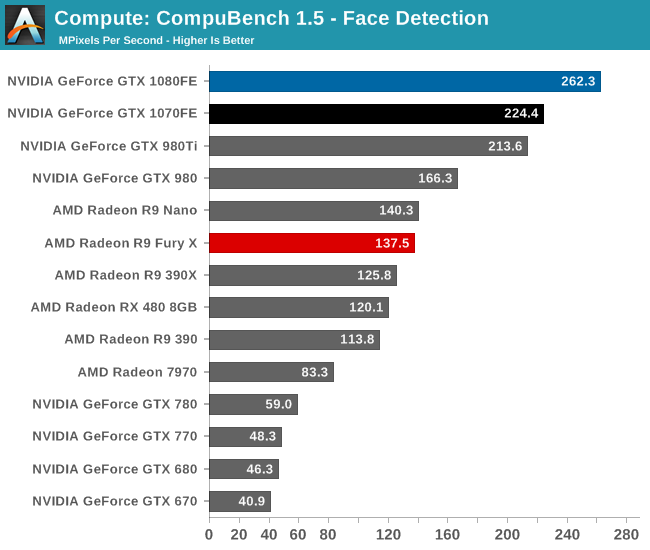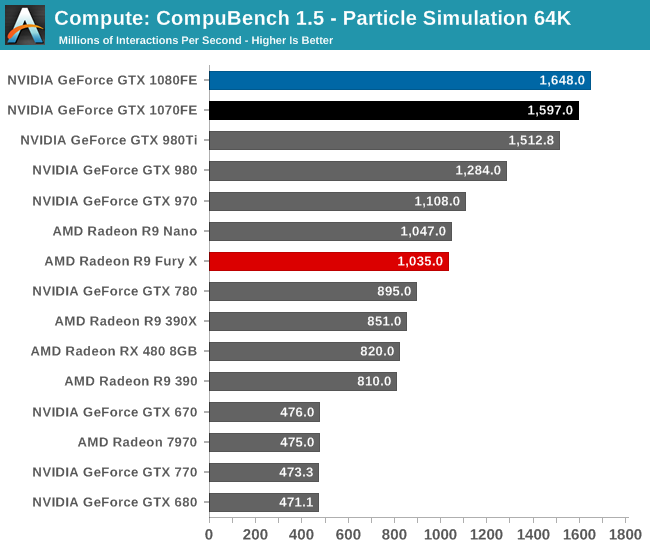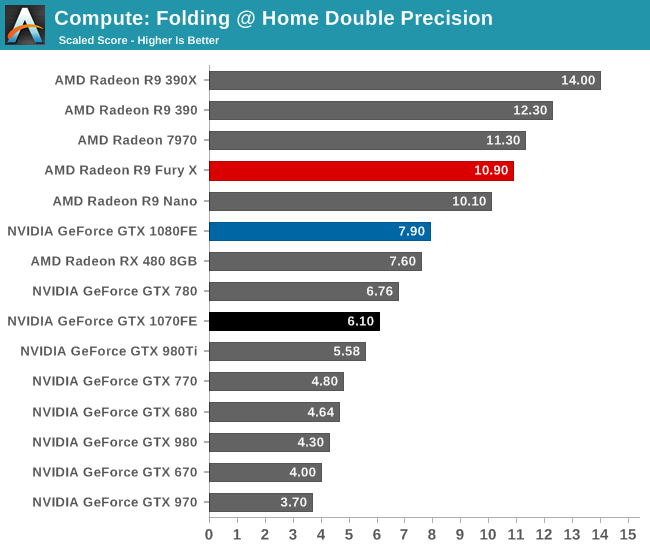The NVIDIA GeForce GTX 1080 & GTX 1070 Founders Editions Review: Kicking Off the FinFET Generation
by Ryan Smith on July 20, 2016 8:45 AM ESTCompute
Shifting gears, let’s take a look at compute performance on Pascal.
Overall, we’re not expecting a significant difference in compute performance compared to Maxwell 2 for standard compute benchmarks. The fundamental architecture hasn’t changed – the CUDA cores, register files, and caches still behave as before - so there’s little reason for compute performance to shift. GP104 for all intents and purposes should perform like a higher clocked and slightly wider Maxwell 2, similar to what we’ve seen in most games.
However in the long run there is potential for Pascal to show some improvements. The architecture’s improved scheduling features are geared in part towards HPC users, and instruction level preemption means that compute kernels can now be a lot more aggressive on consumer systems since they can be paused so easily. That said, to really leverage any of these improvements, applications utilizing GPU compute need to have work that benefits from better scheduling and be written with Pascal in mind, and for consumer workloads the latter is likely a long way off.
Starting us off for our look at compute is LuxMark3.1, the latest version of the official benchmark of LuxRender. LuxRender’s GPU-accelerated rendering mode is an OpenCL based ray tracer that forms a part of the larger LuxRender suite. Ray tracing has become a stronghold for GPUs in recent years as ray tracing maps well to GPU pipelines, allowing artists to render scenes much more quickly than with CPUs alone.

As with games, when it comes to LuxMark, the GTX 1080 is uncontested; this is the first high performance FinFET GPU in action. That said, I’m surprised by how close some of these results cluster. Though GTX 1080 is not a full generational replacement for GTX 980 Ti, normally it outperforms the Big Maxwell card by more than this. Instead we’re looking at a lead of just 10%, notably less than a simple extrapolation of CUDA core counts and frequencies would tell us to expect (GTX 1080 has almost 50% more FLOPs).
That said, GTX 1070 still places very close to GTX 980 Ti – albeit below it – so what we’re seeing isn’t just Pascal being a laggard. Especially since as a consequence of this, GTX 1080 only beats GTX 1070 by 12%. In any case, this may be a case of early drivers, particularly as OpenCL has not been an NVIDIA priority for the last couple of years. Alternatively, as strange as it may be, I’m not ready to rule out LuxMark being CPU limited. It’s something that we’ll have to keep an eye on.
For our second set of compute benchmarks we have CompuBench 1.5, the successor to CLBenchmark. CompuBench offers a wide array of different practical compute workloads, and we’ve decided to focus on face detection, optical flow modeling, and particle simulations.



Depending on which sub-test we’re looking at, CompuBench is all over the place. In Face Detection the GTX 1080 takes a commanding lead, with GTX 1070 easily slotting into second place. On the other hand we have Optical Flow, which NVIDIA cards have traditionally struggled with, where even GTX 1080 can’t unseat Radeon Fury X. Finally in the middle we have the 64K Particle Simulation, which has GTX 1080 in the lead again, but not unlike LuxMark, it also has some interesting clustering going on.
Ultimately each test stresses our GPU collection in different ways, which as we can see greatly influences how the results pan out. Face Detection has always played well to NVIDIA’s strengths, and on a generational basis we get solid scaling from Maxwell 2 to Pascal. Even Optical Flow, which seems to favor raw FLOPs more than anything else, still shows very good gains with Pascal.
Particle Simulation is the outlier in this regard; Pascal’s generational gains are not insignificant, but they’re less than what we’d expect. Furthermore GTX 1080 and GTX 1070 are very closely clustered together despite their much larger difference in FLOPs. This may mean we’re looking at a CPU or driver bottleneck, or possibly some sort of internal path bottleneck. GTX 1080 has more FLOPs and a similar advantage in memory bandwidth, but once you get on chip things get much closer. If nothing else this goes to show that compute benchmarks are much more architecture sensitive than games, which is why we can’t make very broad generalizations for all compute workloads.
Moving on, our 3rd compute benchmark is the next generation release of FAHBench, the official Folding @ Home benchmark. Folding @ Home is the popular Stanford-backed research and distributed computing initiative that has work distributed to millions of volunteer computers over the internet, each of which is responsible for a tiny slice of a protein folding simulation. FAHBench can test both single precision and double precision floating point performance, with single precision being the most useful metric for most consumer cards due to their low double precision performance. Each precision has two modes, explicit and implicit, the difference being whether water atoms are included in the simulation, which adds quite a bit of work and overhead. This is another OpenCL test, utilizing the OpenCL path for FAHCore 21.


In single precision performance, to the surprise of no one the GTX 1080 is solidly in the lead, followed up by the GTX 1070. On a generational basis performance gains are decent, but at 44% for GTX 1080 they aren’t quite as great as we’ve seen from the card elsewhere. Meanwhile the two Pascal cards are again closer than we’d expect, with GTX 1080 leading by only 10%.
As for double precision performance, we can see that even with the higher overall compute throughput of GP104, it still can’t make up for the fact that FP64 performance on the GPU is capped at 1/32 by virtue of so few FP64 CUDA cores, which puts even NVIDIA’s latest and greatest at a disadvantage here. But if nothing else, generational scaling versus Maxwell 2 looks very good, with performance gains closely tracking the theoretical increase in FLOPs.










200 Comments
View All Comments
TestKing123 - Wednesday, July 20, 2016 - link
Sorry, too little too late. Waited this long, and the first review was Tomb Raider DX11?! Not 12?This review is both late AND rushed at the same time.
Mat3 - Wednesday, July 20, 2016 - link
Testing Tomb Raider in DX11 is inexcusable.http://www.extremetech.com/gaming/231481-rise-of-t...
TheJian - Friday, July 22, 2016 - link
Furyx still loses to 980ti until 4K at which point the avg for both cards is under 30fps, and the mins are both below 20fps. IE, neither is playable. Even in AMD's case here we're looking at 7% gain (75.3 to 80.9). Looking at NV's new cards shows dx12 netting NV cards ~6% while AMD gets ~12% (time spy). This is pretty much a sneeze and will as noted here and elsewhere, it will depend on the game and how the gpu works. It won't be a blanket win for either side. Async won't be saving AMD, they'll have to actually make faster stuff. There is no point in even reporting victory at under 30fps...LOL.Also note in that link, while they are saying maxwell gained nothing, it's not exactly true. Only avg gained nothing (suggesting maybe limited by something else?), while min fps jumped pretty much exactly what AMD did. IE Nv 980ti min went from 56fps to 65fps. So while avg didn't jump, the min went way up giving a much smoother experience (amd gained 11fps on mins from 51 to 62). I'm more worried about mins than avgs. Tomb on AMD still loses by more than 10% so who cares? Sort of blows a hole in the theory that AMD will be faster in all dx12 stuff...LOL. Well maybe when you force the cards into territory nobody can play at (4k in Tomb Raiders case).
It would appear NV isn't spending much time yet on dx12, and they shouldn't. Even with 10-20% on windows 10 (I don't believe netmarketshare's numbers as they are a msft partner), most of those are NOT gamers. You can count dx12 games on ONE hand. Most of those OS's are either forced upgrades due to incorrect update settings (waking up to win10...LOL), or FREE on machine's under $200 etc. Even if 1/4 of them are dx12 capable gpus, that would be NV programming for 2.5%-5% of the PC market. Unlike AMD they were not forced to move on to dx12 due to lack of funding. AMD placed a bet that we'd move on, be forced by MSFT or get console help from xbox1 (didn't work, ps4 winning 2-1) so they could ignore dx11. Nvidia will move when needed, until then they're dominating where most of us are, which is 1080p or less, and DX11. It's comic when people point to AMD winning at 4k when it is usually a case where both sides can't hit 30fps even before maxing details. AMD management keeps aiming at stuff we are either not doing at all (4k less than 2%), or won't be doing for ages such as dx12 games being more than dx11 in your OS+your GPU being dx12 capable.
What is more important? Testing the use case that describes 99.9% of the current games (dx11 or below, win7/8/vista/xp/etc), or games that can be counted on ONE hand and run in an OS most of us hate. No hate isn't a strong word here when the OS has been FREE for a freaking year and still can't hit 20% even by a microsoft partner's likely BS numbers...LOL. Testing dx12 is a waste of time. I'd rather see 3-4 more dx11 games tested for a wider variety although I just read a dozen reviews to see 30+ games tested anyway.
ajlueke - Friday, July 22, 2016 - link
That would be fine if it was only dx12. Doesn't look like Nvidia is investing much time in Vulkan either, especially not on older hardware.http://www.pcgamer.com/doom-benchmarks-return-vulk...
Cygni - Wednesday, July 20, 2016 - link
Cool attention troll. Nobody cares what free reviews you choose to read or why.AndrewJacksonZA - Wednesday, July 20, 2016 - link
Typo on page 18: "The Test""Core i7-4960X hosed in an NZXT Phantom 630 Windowed Edition" Hosed -> Housed
Michael Bay - Thursday, July 21, 2016 - link
I`d sure hose me a Core i7-4960X.AndrewJacksonZA - Wednesday, July 20, 2016 - link
@Ryan & team: What was your reasoning for not including the new Doom in your 2016 GPU Bench game list? AFAIK it's the first indication of Vulkan performance for graphics cards.Thank you! :-)
Ryan Smith - Wednesday, July 20, 2016 - link
We cooked up the list and locked in the games before Doom came out. It wasn't out until May 13th. GTX 1080 came out May 14th, by which point we had already started this article (and had published the preview).AndrewJacksonZA - Wednesday, July 20, 2016 - link
OK, thank you. Any chance of adding it to the list please?I'm a Windows gamer, so my personal interest in the cross-platform Vulkan is pretty meh right now (only one title right now, hooray! /s) but there are probably going to be some devs are going to choose it over DX12 for that very reason, plus I'm sure that you have readers who are quite interested in it.